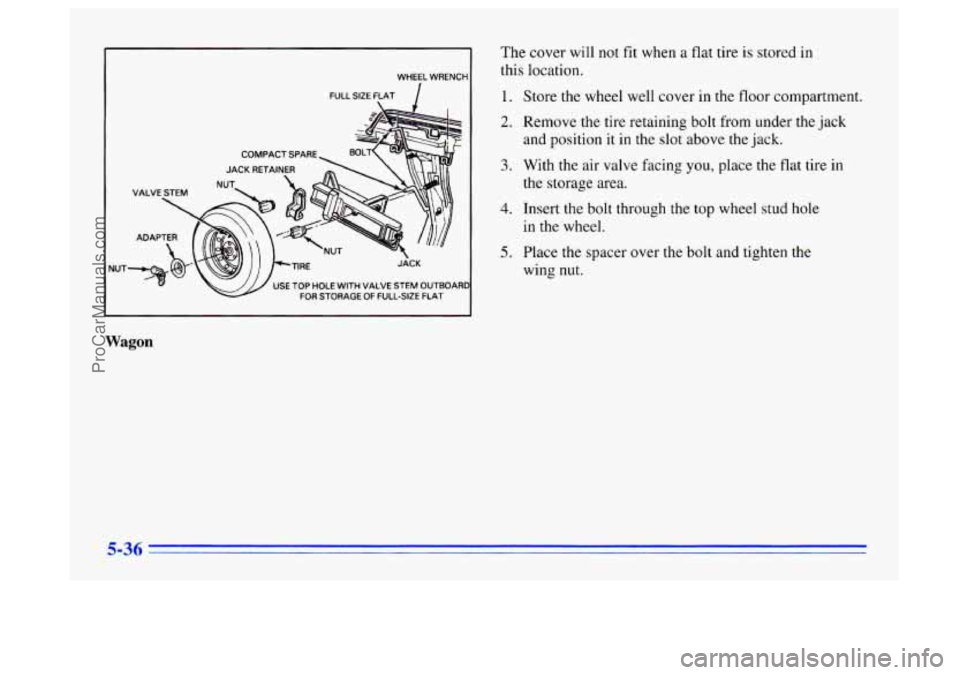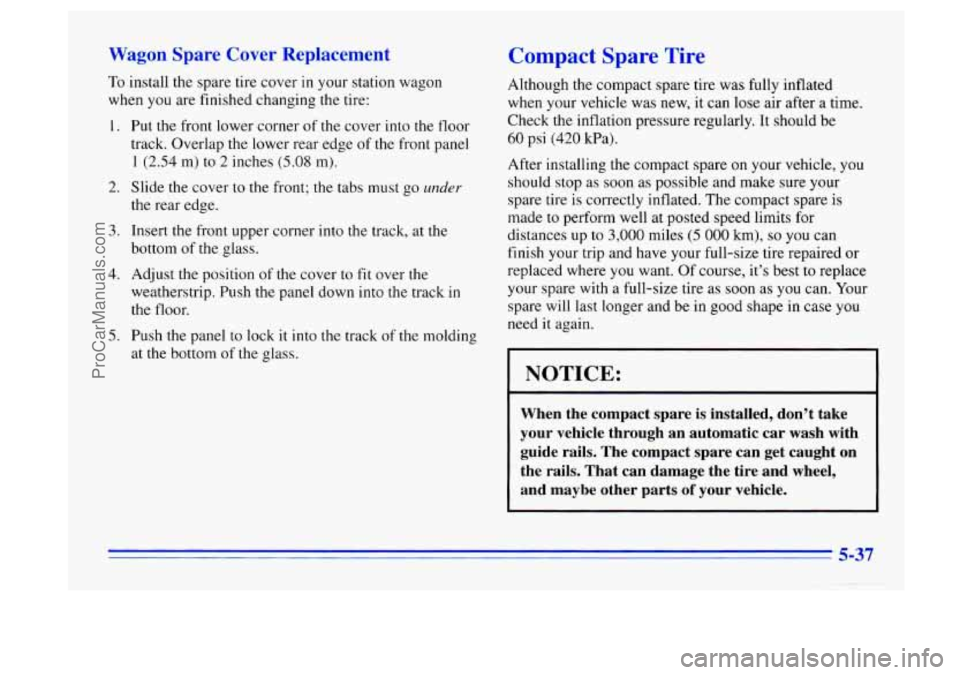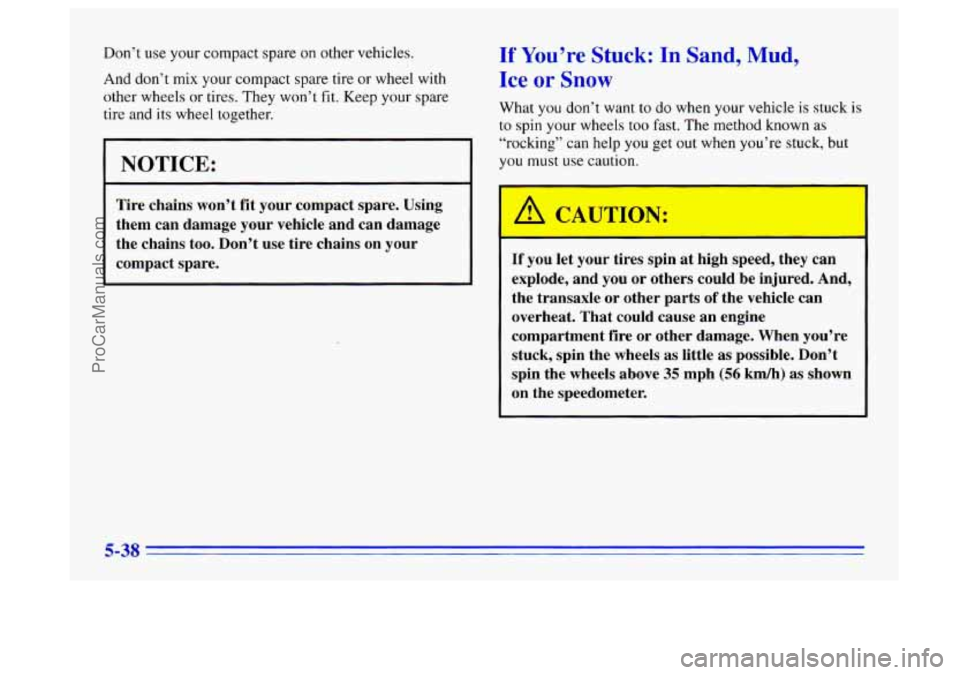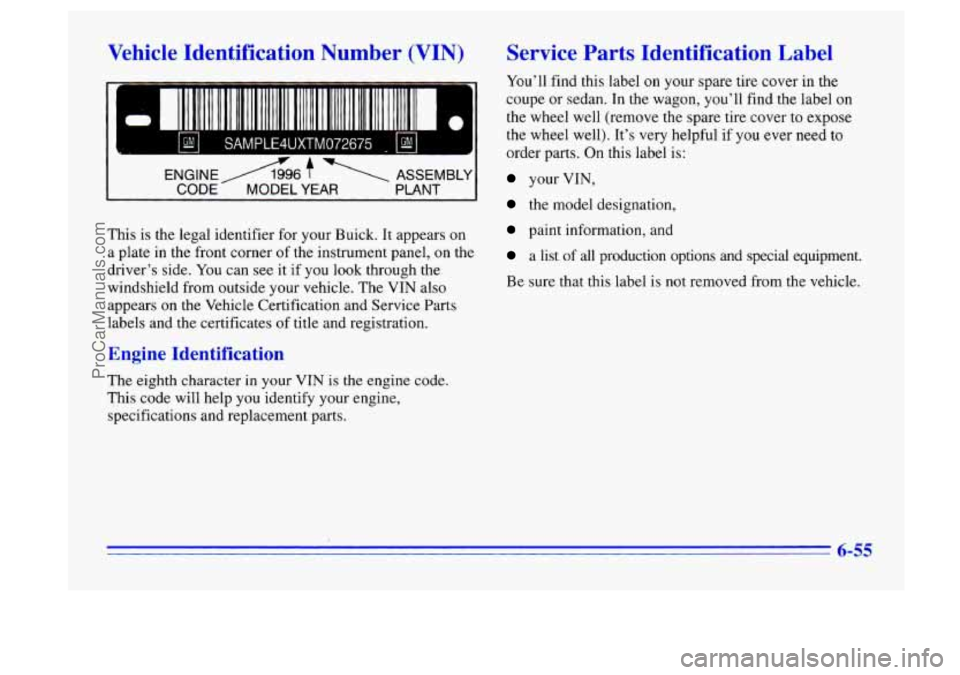1996 BUICK CENTURY spare tire
[x] Cancel search: spare tirePage 202 of 340

NUT
WHEEL WREN0
FULL SIZE FLAT /
COMPACT SPARE,
JACK RETAINER m \\!J JJ In-
JACK
USE TOP HOLE WITH VALVE STEM OUTBOARI:
FOR STORAGE OF FULL-SIZE FLAT
Wagon
The cover will not fit when a flat tire is stored in
this location.
1.
2.
3.
4.
5.
Store the wheel well cover in the floor compartment.
Remove the tire retaining bolt from under the jack
and position it in the slot above the jack.
With the air valve facing you, place the flat tire in
the storage area.
Insert the bolt through the top wheel stud hole
in the wheel.
Place the spacer over the bolt and tighten the
wing
nut.
5-36
ProCarManuals.com
Page 203 of 340

Wagon Spare Cover Replacement
To install the spare tire cover in your station wagon
when you are finished changing the tire:
1.
2.
3.
4.
5.
Put the front lower corner of the cover into the floor
track. Overlap the lower rear edge of the front panel
1 (2.54 m) to 2 inches (5.08 m).
Slide the cover to the front; the tabs must go under
the rear edge.
Insert the front upper corner into the track,
at the
bottom
of the glass.
Adjust the position
of the cover to fit over the
weatherstrip. Push the panel down into the track
in
the floor.
Push the panel
to lock it into the track of the molding
at the bottom of the glass.
Compact Spare Tire
Although the compact spare tire was fully inflated
when your vehicle was new, it can
lose air after a time.
Check the inflation pressure regularly. It should be
60 psi (420 kPa).
After installing the compact spare on your vehicle, you
should stop as soon as possible and make sure your
spare tire is correctly inflated. The compact spare is
made to perform well at posted speed limits for
distances up to
3,000 miles (5 000 km), so you can
finish your trip and have your full-size tire repaired or
replaced where
you want. Of course, it’s best to replace
your spare with a full-size tire as soon as you can. Your
spare will last longer and be in good shape in case
you
need it again.
NOTICE:
When the compact spare is installed, don’t take
your vehicle through an automatic car wash with
guide rails. The compact spare can get caught on
the rails. That can damage the tire and wheel,
and maybe other parts
of your vehicle.
5’ -7
ProCarManuals.com
Page 204 of 340

Don’t use your compact spare on other vehicles.
And don’t mix your compact spare tire or wheel with
other wheels or tires. They won’t fit. Keep your spare
tire and its wheel together.
I NOTICE:
Tire chains won’t fit your compact spare. Using
them can damage your vehicle
and can damage
the chains too. Don’t use tire chains on your
compact spare.
If You’re Stuck: In Sand, Mud,
Ice or
Snow
What you don’t want to do when your vehicle is stuck is
to spin your wheels too fast. The method known
as
“rocking” can help you get out when you’re stuck, but
you must use caution.
)N:
I- -
If you let your tires spin at high speed, they can
explode, and you or others could be injured. And,
the transaxle
or other parts of the vehicle can
overheat. That could cause an engine
compartment fire or other damage. When you’re
stuck, spin the wheels
as little as possible. Don’t
spin the wheels above
35 mph (56 km/h) as shown
on the speedometer.
ProCarManuals.com
Page 245 of 340

Inflation -- Tire Pressure
The Tire-Loading Information label, which is on the
rear edge of the driver’s door, shows the correct
inflation pressures for your tires when they’re cold.
“Cold” means your vehicle
has been sitting for at least
three hours or driven no more than 1 mile (1.6 km).
NOTICE:
Don’t let anyone tell you that, underinflation or
overinflation
is all right. It’s not. If your tires
don’t have enough air (underinflation), you can
get the following:
0 Too much flexing
Too much heat
0 Tire overloading
0 Bad wear
0. Bad handling
0 Bad fuel economy.
NOTICE: (Continued)
NOTICE: (Continued)
If your tires have too much air (overinflation),
you can get the following:
Unusual wear
Bad handling
Rough ride
Needless damage from road hazards.
When to Check
Check your tires once a month or more.
Don’t forget your compact spare tire.
It should be at
60 psi (420 Pa).
How to Check
Use a good quality pocket-type gage to check tire
pressure. You can’t
tell if your tires are properly inflated
simply by looking .at them. Radial tires may look
properly inflated even when they’re underinflated.
Be sure to put the valve caps back
on the valve stems.
They help prevent leaks by keeping out
dirt and moisture.
6-39
ProCarManuals.com
Page 246 of 340

Tire Inspection and Rotation
Tires should be inspected every 6,000 to 8,000 miles
(10 000 to 13 000 km) for any signs of unusual wear.
If unusual wear is present, rotate your tires as soon as
possible and check wheel alignment. Also check for
damaged tires or wheels. See “When It’s Time for
New
Tires” and “Wheel Replacement” later in this section for
more information. When
rotating your tires, always
use the correct rotation
pattern shown here.
Don’t include the compact spare tire in your tire rotation,
After the tires have been rotated, adjust the front and
rear inflation pressures as shown on the Tire-Loading
Information label. Make certain that all wheel nuts are
properly tightened. See “Wheel Nut Torque”
in
the Index.
The purpose
of regular rotation is to achieve more
uniform wear for all tires
on the vehicle. The first
rotation
is the most important. See “Scheduled
Maintenance Services”
in the Index for scheduled
rotation intervals.
1 A CAUTION:
Rust or dirt on a wheel, or on the parts to which
it is fastened, can make wheel nuts become loose
after
a time. The wheel could come off and cause
an accident. When
you change a wheel, remove
any rust or dirt from places where the wheel
attaches to the vehicle. In an emergency, you can
use
a cloth or a paper towel to do this; but be
sure to use
a scraper or wire brush later, if you
need to, to get all the rust or dirt
off. (See
“Changing a
Flat Tire” in the Index.)
6-40
ProCarManuals.com
Page 248 of 340

/I CAUTION:
Mixing tires could cause you to lose control while
driving.
If you mix tires of different sizes or types
(radial and bias-belted tires), the vehicle may not
handle properly, and you could have a crash.
Using tires of different sizes may also cause
damage to your vehicle. Be sure to use the same
size and type tires on all wheels.
It’s all right to drive with your compact spare,
though. It was developed for use
on your vehicle.
Uniform Tire Quality Grading
The following information relates to the system
developed by the United States National Highway
Traffic Safety Administration, which grades tires by
treadwear, traction and temperature performance. (This
applies only to vehicles sold
in the United States.) The
grades are molded on the sidewalls
of most passenger
car tires. The Uniform Tire Quality Grading system does
not apply to deep tread, winter-type snow tires,
space-saver or temporary use spare
tires, tires with
nominal rim diameters of
10 to 12 inches (25 to 30 cm),
or
to some limited-production tires.
While the tires available on General Motors passenger
cars and light trucks may vary with respect
to these
grades, they must also conform to Federal safety
requirements and additional General Motors Tire
Performance Criteria (TPC) standards.
6-42
ProCarManuals.com
Page 261 of 340

Vehicle Identification Number (VIN)
~C. SAMPLE4UXTM072675 -
CODE- MODEL YEAR PLANT I
This is the legal identifier for your Buick. It appears on
a plate in the front corner of the instrument panel,
on the
driver’s side. You can see it if
you look through the
windshield from outside your vehicle. The
VIN also
appears on the Vehicle Certification and Service Parts
labels and the certificates
of title and registration.
Engine Identification
The eighth character in your VIN is the engine code.
This code will help you identify your engine,
specifications and replacement parts.
Service Parts Identification Label
You’ll find this label on your spare tire cover in the
coupe
or sedan. In the wagon, you’ll find the label on
the wheel well (remove the spare tire cover to expose
the wheel well). It’s very helpful
if you ever need to
order parts. On this label
is:
your VIN,
the model designation,
paint information, and
a list of all production options and special equipment.
Be sure that this label is not removed from the vehicle.
6-55
ProCarManuals.com
Page 330 of 340

Trailer ...................................... 4-33
Transaxle Shift Interlock
....................... 2-23
Transaxle Shift Interlock Check
.................. 7-39
Wear
....................................... 6-31
Brakes. Anti-Lock
............................... 4-6
Braking
........................................ 4-5
Braking in Emergencies
........................... 4-8
Break.In. New Vehicle
.......................... 2- 10
BTSI
......................................... 2-23
BTSICheck
................................... 7-39
Bulb Replacement
.............................. 6-33
Canadian Roadside Assistance
.................... 8-4
Capacities and Specifications
...................... 6-6 1
Carbon Monoxide .................... 2.24.4.27. 4.33
Cargo Security Cover
............................ 2-40
Cassette Deck Service
........................... 7-37
Cassette Tape Player
............................. 3-6
Cassette Tape Player Care
......................... 3-9
Center Passenger Position
........................ 1-27
Certification Label
.............................. 4-28
Chains. Safety
................................. 4-33
Chains. Tire
................................... 6-45
Checking Your Restraint Systems
.................. 1-46
Chemical Paint Spotting
.......................... 6-53
Child Restraints
................................ 1-33
Securing in the Center Seat Position
.............. 1-36
Changing a
Flat Tire
.. t. .......................... 5-24
Securing
in a Rear Outside Seat Position ........... 1-34
Securing in
the Right Front Seat Position .......... 1-38
TopStrap
................................... 1-33
WheretoPut
................................ 1-33 Cigarette
Lighter
............................... 2-42
Circuit Breakers and Fuses
....................... 6-57
Cleaner. Air
................................... 6-14
Cleaning
...................................... 6-46
Aluminum Wheels
............................ 6-51
Fabric
...................................... 6-47
Glass
....................................... 6-49
Inside
of Your Buick .......................... 6-46
Instrument Panel
............................. 6-49
Leather
..................................... 6-49
Outside
of Your Buick ......................... 6-50
Special Problems
............................. 6-48
Stains
...................................... 6-48
Tires
....................................... 6-52
Vinyl ....................................... 6-48
Wheels
..................................... 6-51
Windshield and Wiper Blades
................... 6-50
Climate Control System ........................... 3-1
Clock. Setting the
................................ 3-4
Coinholder
.................................... 2-39
Comfort Controls
................................ 3-1
Compact Spare Tire
............................. 5-37
Control of a Vehicle .............................. 4-5
Convenience Net
............................... 2-40
Convex Outside Mirror
.......................... 2-38
Coolant
....................................... 6-22
Bleedvalves
................................. 5-21
Heater. Engine
............................... 2-14
RecoveryTank
............................... 5-16
Courtesy Lamps
................................ 2-35
Courtesy Transportation
........................... 8-5
Cover. Cargo Security ........................... 2-40
Cooling System
................................ 5-15
9-2
ProCarManuals.com